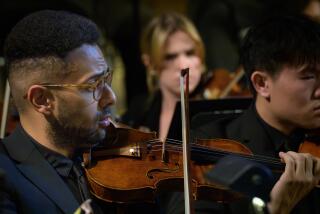Smaller Groups, Youthful Enthusiasm
- Share via
Up close and personal might be the best way to describe the concert by the Henry Mancini Institute Jazz Chamber Ensembles on Thursday night at UCLA’s Schoenberg. After a three-week schedule dominated by larger ensembles--including the 80-piece HMI Orchestra--it was a pleasure to experience the playing of the Institute’s talented young professionals in smaller, more intimate combinations.
Although the individual segments were relatively brief, each ensemble offering glowed with an impressive combination of youthful enthusiasm and technical proficiency. Jeremy Cohen’s strings and rhythm section group included his well-crafted settings of the theme from “The Pink Panther” (one of Mancini’s most popular numbers) and Dave Brubeck’s “Blue Rondo a la Turk.” Best of all, the individual string players all had brief opportunities to improvise--at varying levels of expertise, but with irresistible enthusiasm.
Lesa Terry also led a string ensemble, in her case with a rhythm section enhanced by hand percussion. Her program looked toward the South for inspiration, featuring Ernesto Lecuona’s “Al Fin Te Vi” and a rendering of “Swing Low, Sweet Chariot” that shifted colorfully through African and Cuban rhythms.
Paul McCandless, perhaps best known for his work with the group Oregon, featured a pair of his compositions for woodwind ensemble: “Sarabande” and “All the Mornings Bring”--for woodwind ensemble. Adept on oboe, English horn, bass clarinet and saxophones, his understanding of the diverse timbral combinations possible from such a grouping resulted in some extraordinary textures, from the dark-toned combination of bass clarinets and bassoon to the playful, upper-register interplay of clarinet and oboe.
Billy Childs’ “A View of the City” was a showcase setting for all-star bassist Christian McBride, and--as in past HMI programs--he made the most of it. Jazz bass playing, in recent years, has become almost frighteningly virtuosic, and McBride is fully capable of finger busting with the best.
But, as he revealed in his soloing here, McBride’s improvisations have a purpose, a musical goal reaching beyond the simple display of technical firepower. And Childs, whose compositional skills seem to be growing by leaps and bounds, again affirmed his capacity to write creatively for virtually any instrumental combination.
One caveat about the otherwise entertaining evening: As in several other HMI performances, faculty members moved a bit too far beyond their roles as instructors, taking solo spots for themselves rather than, as one might expect and hope, using every opportunity to allow the HMI players to display their talents.
The Institute’s quoted mission, after all, is to “provide the answer to what it means to be a professional musician in today’s world.” And actual performing experience--as soloists and ensemble players--is the only real way to find that answer.
More to Read
The biggest entertainment stories
Get our big stories about Hollywood, film, television, music, arts, culture and more right in your inbox as soon as they publish.
You may occasionally receive promotional content from the Los Angeles Times.










